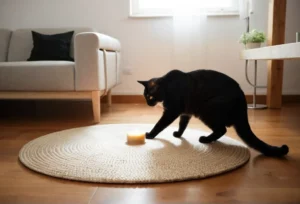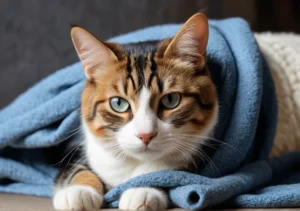Cats and dogs are known for exhibiting quirky behaviors that often leave us puzzled. One common phenomenon many pet owners have observed is their furry friends circling before lying down. Have you ever wondered why our beloved pets engage in this curious ritual? Let’s explore the reasons behind this fascinating behavior in cats and dogs.
Evolutionary Instincts
Have you ever noticed your cat or dog circling before settling down for a nap? This seemingly quirky behavior actually has deep roots in their evolutionary history. Cats and dogs, being descendants of wild animals, have inherited a survival instinct that drives them to prepare their sleeping spot before letting their guard down. In the wild, circling helped their ancestors flatten any grass or foliage that could conceal dangerous predators like snakes or other threats. This instinct to circle before lying down is hardwired into their brains, ensuring they have a safe and secure place to rest.
Moreover, circling serves another useful purpose for cats. As territorial animals, cats circle to mark their scent on the area, making it feel more like home and deterring other animals from encroaching on their space. This behavior also helps them lay claim to the spot, creating a sense of ownership and safety. So next time you catch your furry friend circling before curling up, remember it’s just their evolutionary instincts at play.
Safety and Security
Creating a cozy and secure sleeping environment is essential for cats and dogs to feel at ease. Circling before lying down allows them to survey their surroundings, ensuring there are no immediate threats nearby. This ritualistic behavior helps them find the perfect position to rest, free from any potential dangers. For dogs, circling can also be a way to regulate their body temperature by flattening the ground to create a cooler or warmer sleeping spot, depending on the weather.
In addition to safety, circling helps cats and dogs relax and unwind before settling in for a nap. Just like how humans might fluff their pillows or adjust their blankets before bed, circling is a way for our furry companions to prepare themselves physically and mentally for sleep. Providing them with a comfortable and secure space to rest is crucial for their overall well-being and happiness.
Extra Tip: To further enhance your pet’s sleeping environment, consider placing a cozy bed or blanket in their favorite spot, giving them a designated place to unwind and feel safe.
Temperature Regulation
Have you ever noticed your furry friend circling before settling down for a nap? Well, this seemingly quirky behavior actually serves a purpose, particularly when it comes to regulating body temperature. Cats and dogs have a natural instinct to create a comfortable sleeping spot that is just right in terms of warmth or coolness. By circling before lying down, they are able to pat down the area and potentially adjust the temperature of the surface they are about to rest on. This circling motion helps them find the perfect spot to get cozy, whether it’s ensuring they’re on a warmer part of the floor in a chilly room or seeking out a cooler patch on a hot day. So the next time you catch your pet circling before curling up, know that they are just trying to find the optimal snooze spot!
Establishing Territory
When your cat or dog circles before settling down, they are doing more than just trying to get comfortable – they are also engaging in a primal instinct to mark their territory. By walking around and pawing at the area, they are essentially claiming that spot as their own. This behavior harkens back to their wild instincts where animals would mark their territory to establish ownership and potentially ward off any unwanted intruders. So, the next time you see your furry companion circling around before lying down, remember that they are not just preparing for a nap but also subtly asserting their claim over that space. It’s their way of turning a simple sleeping spot into a familiar and safe haven in their environment.
Additional Unique Insight:
- Cats and dogs may also circle before lying down to flatten out any potential debris or uncomfortable objects on the ground, creating a smoother surface for themselves to rest on. This action not only helps them get comfortable but also ensures a clean and safe spot for their nap.
Comfort and Habit
Circling before lying down is a common behavior seen in both cats and dogs. This quirky ritual may simply be a way for our furry friends to find comfort and establish a sense of security before settling in for a nap or a good night’s sleep. It’s akin to us fluffing our pillows or adjusting our blankets before snuggling in for the night. So, if you see your pet circling a few times before plopping down, it’s likely just their way of creating a cozy spot to rest.
Moreover, circling could also be a deeply ingrained habit for many cats and dogs. It’s something they’ve been doing instinctively for generations, passed down from their wild ancestors who would circle to flatten down the grass or leaves to create a comfortable resting spot in the wild. So, next time you catch your furry companion making circles before lying down, remember that it’s their way of feeling at ease and embracing their natural instincts.
For an additional unique insight: Studies suggest that circling before lying down can also help cats and dogs check their surroundings for safety and potential threats, a behavior linked to their survival instincts from their ancestors in the wild. By circling, they can assess their environment and ensure they are in a secure spot before relaxing.
Medical Concerns
While circling before lying down is typically harmless, in some cases, it can be a cause for concern. If you notice that your pet suddenly starts circling excessively or obsessively, it could be a sign of an underlying medical issue that requires attention. Conditions such as ear infections, neurological problems, or joint pain can manifest as increased circling behavior in cats and dogs.
If you observe your pet displaying unusual circling patterns, along with other symptoms like disorientation, drooping of the head, or difficulty walking, it’s essential to consult with a veterinarian. These signs could indicate a serious health issue that needs to be addressed promptly to ensure the well-being of your furry friend.
Remember, while circling is usually just a harmless quirk, it’s crucial to stay vigilant and be attuned to any changes in your pet’s behavior that may signal an underlying medical condition. Prioritize your pet’s health and seek professional guidance if you have any concerns about their circling habits.
For further information on pet health concerns and behaviors, you can refer to reputable sources like the American Veterinary Medical Association (AVMA) website.
Training and Behavior Modification
Ever found your furry friend doing circles on repeat before settling down for a nap? If this behavior becomes excessive or problematic, fear not! You can train your pets to break this habit. One effective method is redirection – when you notice your cat or dog starting to circle excessively, gently guide them to their bed or designated resting area. Reward them with treats and praise for lying down without circling. Consistency is key, so be patient and provide positive reinforcement every time they successfully skip the spinning routine. Remember, each pet is unique, so tailor your training approach to suit their individual needs and personality.
Fun Facts
Did you know that the circling behavior in cats and dogs has a historical origin? Back in the wild, wild days, before domestication, animals would circle to create a comfortable sleeping spot. By circling, they would flatten the grass or foliage beneath them, making a cozier and safer place to rest. While our modern pets don’t necessarily need to plump their pillows, this instinctual behavior remains a part of their DNA. So, the next time you catch your pet making circles before a snooze, remember they’re just following their ancestral instincts, preparing for a good night’s sleep. And who knows, maybe you’ll appreciate their routine a bit more knowing the fascinating history behind it!
Alex, a passionate animal lover, has experience in training and understanding animal behavior. As a proud pet parent to two dogs and three cats, he founded AnimalReport.net to share insights from animal experts and expand his knowledge of the animal kingdom.




